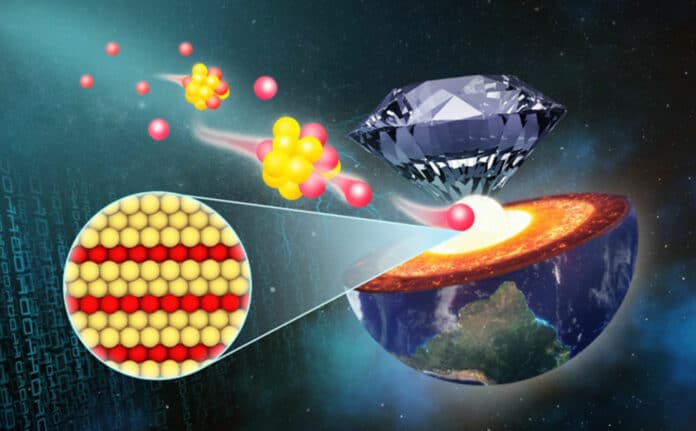Oxygen and iron are the most abundant elements on Earth, and their compounds are key planet-forming components. While oxygen is pervasive in the mantle, its presence in the solid inner core is still debatable.
Researchers led by Dr. Yang Sun of Columbia University and Dr. Jin Liu of HPSTAR (the Center for High-Pressure Science & Technology Advanced Research) have discovered that Fe-rich Fe-O alloys are stable at as high as nearly 300 GPa and temperatures as high as 3,000 K. The findings suggest that oxygen can exist in the solid inner core, which provides key constraints for further understanding the formation process and evolution history of the Earth’s core.
Because the inner core is out of human reach, we can only guess at its density and chemical makeup from the seismic signals that earthquakes produce. Though their type and composition are still up for debate, it is now thought that the inner core contains light components. It is predicted by cosmochemical and geochemical data to include sulfur, silicon, carbon, and hydrogen. Calculations and experiments also supported the finding that under the deep Earth’s high temperatures and high pressures, these elements combine with pure iron to create a variety of Fe alloys.
However, oxygen is usually excluded from the inner core as Fe-O alloys with iron-rich compositions have never been found in the surface or mantle environments. All known iron oxides have an oxygen concentration of more than or equal to 50% by atomic percentage. Although attempts have been made to create iron oxide compounds with compositions high in iron, no such materials have yet been discovered. Is the core of the Earth so “anoxic”? In this work, several tests and theoretical computations were done to provide an answer to this question.
Pure iron and iron oxide were placed on the ends of two diamond anvils and fired with a high-energy laser beam to a temperature and pressure close to the Earth’s core. After numerous efforts, it was discovered that above 220-260 GPa and 3000 K, a chemical reaction between iron and iron oxide takes place. According to the XRD data, the reaction product is distinct from the typical high-temperature and high-pressure structure of pure iron and iron oxide.
A genetic algorithm-based theoretical crystal structure search has shown that the iron-rich Fe-O alloy may survive steadily at a pressure of about 200 GPa. The novel Fe-rich Fe-O alloys develop a hexagonal close-packed structure in such circumstances, with the oxygen layers positioned in between the Fe layers to support the structure. A process like this creates many Fe-rich Fe-O compounds with high configurational entropy and closely packed configurations. This theoretical data was used to identify a Fe28O14 atomic arrangement that matched the experimentally recorded XRD pattern.
Further calculations showed that Fe-rich Fe-O phases are metallic, contrasting with common iron oxides at low pressures. The electronic structure depends on O concentration and the Fe and O layer arrangements. The mechanical properties and thermal properties of the alloy need to be further studied in the future.
Journal Reference:
- Jin Liu, Yang Sun et al. Iron-rich Fe–O compounds at Earth’s core pressures. The Innovation. DOI: 10.1016/j.xinn.2022.100354
